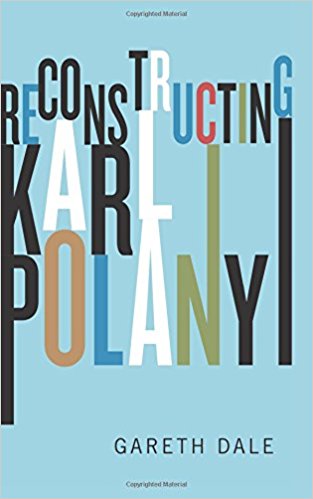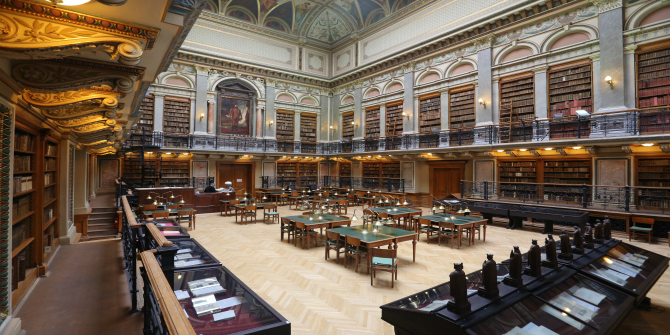.
Gareth Dale’s latest book on the social theory of Karl Polanyi is a magisterial culmination of the author’s extensive decade-long research on the life and thought of ‘one of the most influential political economists of the twentieth-century’. As Dale highlights in an interview on the distinctive contributions of the three main book-length studies that have emerged from the project: ‘the emphasis of the biography is on [Polanyi’s] life and times, that of Karl Polanyi: The Limits of the Market is on exegesis and analysis, while that of Reconstructing Karl Polanyi is on critique’. Moreover, there is the edited collection Karl Polanyi: The Hungarian Writings, which brings together in one volume 56 texts made available in English for the first time. While each is praiseworthy in its own right, approaching them holistically guarantees an exceptionally rewarding intellectual expedition whose aim is to ‘reconstruct’ Polanyi, to ‘re-present’ his ideas ‘with attention to their historical and discursive context and drawing on a much broader range of sources’ than what the previous critical literature has had at its disposal (10).
The critical aims of Reconstructing Karl Polanyi are pursued in nine chapters. First, the author attempts to position Polanyi in respect to the various intellectual traditions of the ‘satanic science of sociology’ (18), then he examines his work in relation to different variants of Marxist thought and analysis. In fact, as Dale proposes at the very beginning, the ‘book covers a range of topics but its central thread concerns Polanyi’s relationship with socialist politics and ideas’ (8). Some concrete questions in this respect – such as Polanyi’s views on the connections between capitalism and democracy (or economics and politics), his assessment of the Soviet model of ‘actually existing socialism’ and strategies of coping with McCarthyism during a historical period in which Polanyi himself may have been ‘nudged “a little to the right”’ (160) – are posed in Chapters Three, Four and Seven respectively. Chapter Five looks closely at Polanyi’s masterwork, The Great Transformation (‘a deeply personal book’ that ‘no one but Polanyi could have written’ [99]), while Chapter Six casts a Polanyian eye on questions of regional integration and internationalism. The final two chapters focus on Polanyi’s later work on ‘ancient economic history’, specifically the function of markets in Mesopotamia and ancient Greece.
What connects the chapters to the teleological motif of theoretical ‘reconstruction’ is the recognition that, with respect to the topics discussed, Polanyi has ‘been subject to divergent interpretations’ (10). This has been as much due to carelessness on the part of his interpreters as to his own tendency towards conceptual inconsistency, semantic slippage and contradiction. His politics can be assessed either as social-democratic in a ‘soft’ interpretation (4) or as ‘red-blooded socialist’ in a ‘hard’ reading (5); his critique is aimed, according to some, at ‘capitalism’, while for others it merely targets ‘laissez-faire liberalism’ (123).
Image Credit: University library of Eötvös Loránd University, Budapest, Hungary, of which Karl Polanyi was an alumnus (Thaler CC BY SA 3.0)
To a great degree, Polanyi’s idiosyncrasies originate in his early intellectual development in the Austro-Hungarian melting-pot of peoples and ideas, as Dale’s broader project aims to stress. In Dale’s reading, while this may render Polanyi susceptible to misinterpretation, it is also the source of his originality: many aspects of his arguments ‘were being developed more or less simultaneously by others, but when filtered through his Christian-socialist outlook, and his idiosyncratic blend of socialist and Austrian conceptions of protectionism, the result was uniquely his own’ (122).
The sources of some contradictions, alternately, can be traced back to procedural or personal characteristics. As Dale’s ‘reconstruction’ evidences, for instance, common misunderstandings of the concept of ‘protectionism’ deployed in The Great Transformation emanate not only from Polanyi’s polysemic use of the term, but also from inconsistent revisions made to the original manuscript, which resulted in rolling ‘two distinct meanings of protection […] into one’ (119).
On the other hand, the formative influence that the ‘Austrian school’ had on Polanyi seems to have persisted throughout his lifetime, engrained in personal dispositions. This is hinted at by Dale when he assesses Polanyi’s other significant late-career body of work on trade and markets in pre-modern societies. The latter’s contribution to the understanding ‘of forms of pre-modern economic integration’ has ‘revolutionised the primitivism-modernism controversy’ (200), although it did not settle the debate between ‘primitivists’ and ‘modernists’ or ‘substantivists’ and ‘formalists’ (somewhat simplistically, between those proposing that the rationality assumptions and formal methodologies of modern microeconomics can be applied to the economic activities of past or ‘primitive’ peoples, and those challenging this idea). According to Dale, one of the reasons why the subsequent, supposedly synthesising New Institutionalist Economic History approach spearheaded by Douglass North – whose real achievements are vigorously questioned by Dale in the closing chapter – could emerge as victorious over the ‘sterility’ of these previous debates, was Polanyi’s ‘unwillingness (or inability) to critique [the formalists’] claims to have provided a valid method for understanding market societies’ (201, emphasis added). These shortcomings notwithstanding, ‘however, his substantivist “challenge” remains’ (201).
Overall, Dale’s complementary aims of conceptual archaeology and reconstructive critique are well balanced throughout the book. The one chapter where these aims, and Polanyi’s own work, are significantly transcended is the one on regionalism and the European Union. Here Dale takes on a topic of particular concern to him, but one in which ‘Polanyi expressed scant interest’ (128). The discussion therefore centres on assessing contemporary Polanyi-inspired research on the nature of the EU; and it is here that Dale’s voice comes through in its most critical tone: ‘any lingering illusions in the social-democratic configuration of the European project were pitilessly dispelled in the first decades of the present century’ (137). ‘If any “Polanyian content” is to be found’ in the political promise of the European project, ‘it will be in public debates over, and protests against, EU market integration’ (135). Yet, in light of the already mentioned idiosyncratic tendencies in Polanyi’s theory, one cannot but wonder whether, in contrast to currently dominant critiques from the left, a ‘Polanyian’ stance would not be more accommodating – albeit in ‘unique’ ways – of the ‘Hayekian setting’ of the EU.
In conclusion, the book lives up to its promise of reconstructing some of Polanyi’s elusive concepts, and does so in Dale’s always engaging style. However, Reconstructing Karl Polanyidoes feel occasionally dense: for readers seeking an easy point of entry into Polanyi’s writings, Dale’s previous works are probably a better starting point. As to its broader message, in the current political-economic conjuncture Polanyi is more alive than ever, but also better shielded from his own rekindled popularity. Following Dale’s feat, few acceptable justifications remain for Polanyi’s misinterpretation and misappropriation.


No comments:
Post a Comment